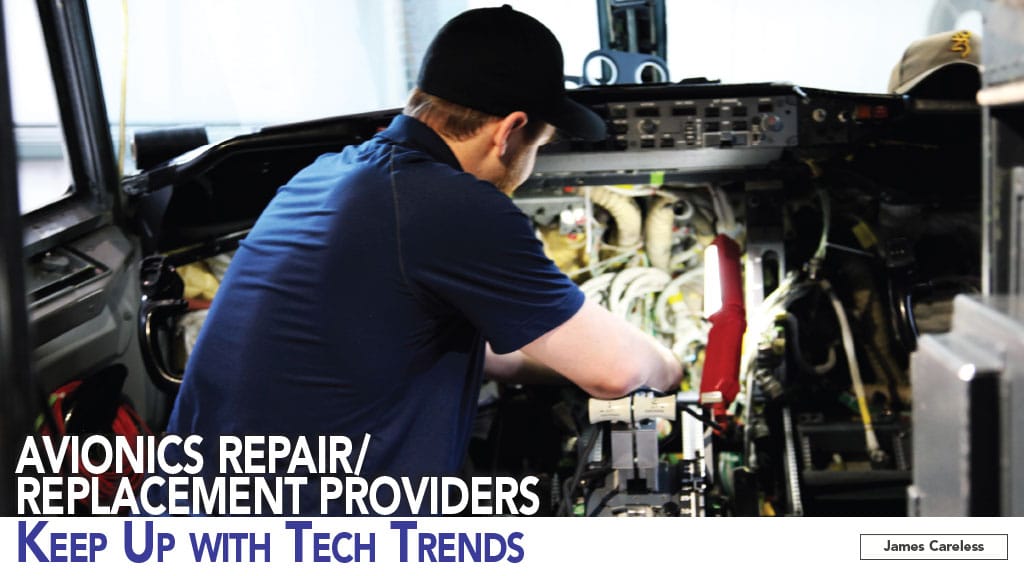As the world’s aircraft become more sophisticated, so too do the avionics that control them. This is why avionics repair/replacement providers are keeping up with technology trends that are changing the fundamentals of flight.
Change Abounds
To say the least, there are many technology trends that avionics repair providers are responding to. “They include increased remote diagnostics capabilities to service avionics in distant AOG (Aircraft on Ground) situations, methods to decrease turnaround times to return avionics to service sooner, and increased capabilities to support expedited projects,” said Don Milum. He is Director of North American Sales for Universal Avionics. “We are also fielding upgrades and replacements of older, less reliable avionics units as a means of reducing the overall requirement for repairs in total,” Milum said. Overall, “our connectivity solutions can reduce nav database loading time by 75%.”
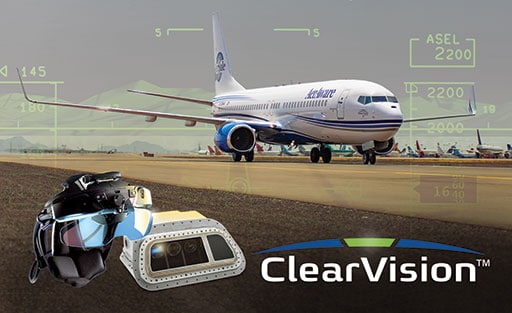
Headquartered in Tucson, Arizona, Universal Avionics’ product/serving portfolio includes Flight Management Systems, Display Systems/Glass Cockpit [Insight], Enhanced Flight Vision Systems (ClearVision], Data Communications, Recorders [Kapture], Databases, and Flight Deck Connectivity.
Universal Avionics is also applying breakthroughs in artificial intelligence, remote diagnostics and augmented reality to its avionics repair procedures and processes. These software tools are being combined with connectivity troubleshooting and maintenance data compilation that can be sent back to the avionics OEMs for advanced diagnostics. “The shop can pinpoint issues before a unit is actually sent back for repair, thus reducing the time for the overall repair/support process,” Milum said.

Honeywell Aerospace is also keeping abreast of the latest avionics’ technological trends, with the goal of leveraging whatever benefits they have to offer. A case in point: “At a subcomponent level, we are continuously evaluating different applications of technology whether it is thermal imaging or JTAG technology,” said Jason Bialek, Honeywell Anthem product line director, Honeywell Aerospace.” Overall, Honeywell remains focused on robust testing capabilities that ensure the reliability and safety of our products,” he said.
With its headquarters in Phoenix, Arizona, Honeywell Aerospace is the largest division of the Honeywell conglomerate. Honeywell Aerospace products and services are found on virtually every commercial, defense and space aircraft. The Aerospace business unit builds aircraft engines, cockpit and cabin electronics, wireless connectivity systems and mechanical components.
Because Honeywell Aerospace is also an avionics OEM, the company is addressing the aviation market’s demand for more advanced inflight avionics directly. This is why it launched its new Honeywell Anthem flight deck system in October 2021.
“Honeywell Anthem is the first cockpit system in the industry to be built with an always-on, cloud-connected experience that improves flight efficiency, operations, safety and comfort,” said Bialek. “The Honeywell Anthem flight deck offers unprecedented levels of connectivity, an exciting and intuitive interface modeled after everyday smart devices, and a highly scalable and customizable design.” This product is based on a flexible software platform that can be customized for virtually every type of aircraft and flying vehicle, he added. They include large passenger and cargo planes, business jets, helicopters, general aviation aircraft, and advanced air-mobility (AAM) vehicles.
At Flying Colours Corporation in Peterborough, Ontario, (Canada), improving inflight connectivity is an increasingly important part of their avionics business. (The company also provides MRO services, completions, refurbishments, special mission modifications, exterior paintwork, and aircraft transaction support for fixed wing and rotary business aircraft types.)
“Our work predominantly focuses on mid- to large-size jets: We find the Gogo AVANCE L3/5 inflight connectivity technology is proving very popular with a lot of owners who fly predominantly in North America,” said Kevin Kliethermes, Flying Colours’ sales director. “We’ve also recently completed installing Ka-band satellite connectivity technology on a Challenger aircraft type, which is a first for us. We’ve installed many on super mid-size aircraft, but this is the first time we’ve installed the powerful broadband offering on a super midsize aircraft. We anticipate this will become a more regular request as we find more and more customers do not want to fly without connectivity.”
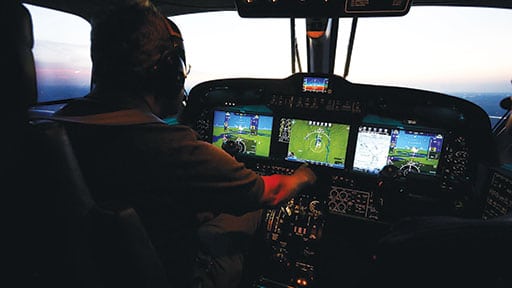
I Flying Colours is modernizing other avionics systems on its clients’ aircraft as well. “In terms of upgrading flight decks, the Collins Pro-Line Fusion solution is giving a new lease on life to older aircraft,” Kliethermes said. “The Collins Venue Cabin Management System is proving popular with our customers too. We’ve been working closely with Alto Aviation to optimize its installation. Alto Aviation’s controls are specifically designed to fit into previous switch panel location holes. This results in a CMS upgrade that maximizes client budget and reduces installation time significantly.”
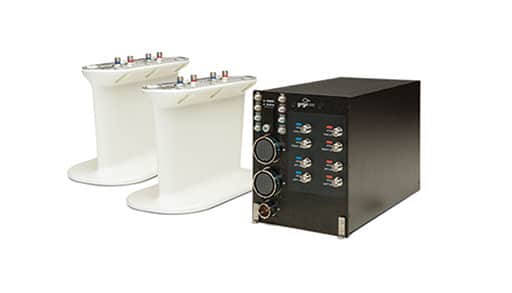
These kinds of avionics modernizations make good sense at a time when older, less sophisticated avionics systems are becoming harder to maintain. “Component obsolescence appears to be the biggest challenge with avionics these days,” said Bill Arsenault. He is president of Mid-Canada Mod Center in Mississauga, Ontario, which provides turnkey avionics installations and repairs to a wide variety of corporate and commercial customers. “Parts to repair older equipment are becoming more difficult to get,” Arsenault explained. “This is driving more avionics upgrades. However, manufacturers do not have modern solutions available for every case.”
Mid-Canada’s core business is custom avionics upgrades. They offer avionics upgrades such as major cockpit retrofits, internet connectivity and navigation system enhancements to a wide variety of business and commercial customers.
One last tech trend being addressed by the avionics repair/replacement sector is the shortage of up-to-date skilled technicians. Honeywell Aerospace is addressing this problem through various innovations. “We need technicians to be able to reach proficiency quickly, so it will be important to simplify the training and product diagnostic process,” said Bialek. “To make this happen, Honeywell is exploring digital training and collaborative tools, as well as technologies that accelerate the troubleshooting process.”
The Pros and Cons of COVID
For the past two years, the work being done by avionics repair/replacement providers has been performed in the shadow of COVID-19. And for once, the news related to the pandemic’s impact isn’t all bad.
In the case of avionics repair and replacement, “the pandemic caused a surge in private aviation, driving demand for more aircraft than was/is available,” Milum said. “This has meant that airframes that have fallen out of favor over the last several years due to avionic obsolescence and rising repair costs have found new life by owners upgrading their avionics in total. Legacy equipment is being replaced to improve dispatch rates and operational compliance in all areas of airspace around the globe, which is our wheelhouse.”
This being said, avionics repair and replacement providers faced their own challenges for the past two years. According to Bialek, “the COVID-19 pandemic has affected companies in every sector, and Honeywell is no exception. However, while the current pandemic deeply affected the aviation industry in 2020, we’ve seen a steady recovery since, and we are confident in the industry’s long-term growth potential.”
“COVID has created challenges on many fronts,” said Mid-Canada’s Arsenault. To cope with them, “keeping our staff and customers safe has been our core strategy from the start of the pandemic. This strategy has kept us from having infections spread in our workplaces. However, this has increased our costs, which for the most part we have not passed on to our customers. As well, the more recent supply chain issues caused by the pandemic are increasing lead times on parts and components, and causing work delays and disruptions.”
Being an aircraft repair station, Flying Colours was deemed an essential service by the authorities in the USA, Canada and Singapore. As a result, it was exempted from lockdowns in its respective locations, and was able to keep providing a full range of services to its clients worldwide.
“Our work has continued, although some customers have delayed work — such as those owning aircraft in Europe who have been restricted on flying due to changing travel restrictions,” Kliethermes said. “Other customers have moved their maintenance schedules forward: As regular flying was restricted, they used that downtime to undertake maintenance work. This work regularly includes SATCOM/connectivity upgrades, as we always advise our customers to install systems that will remain current for years to come.”
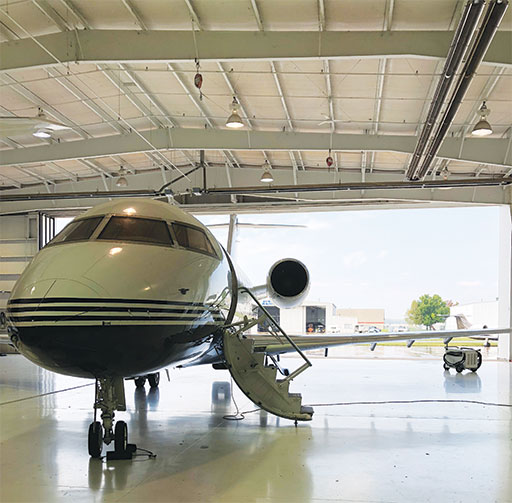
“We reworked our organization so that our shifts enabled us to keep working while sticking to the government guidelines,” he added. “We produce many of the components that are installed ourselves, which means we were less reliant on the supply chain than many companies. This allowed us to keep finishing projects on time.”
Looking Ahead
When avionics repair/replacement providers are asked to look to the future, they respond by looking past COVID to a big picture issue — namely the evolving state of avionics repairs/replacements as modern aircraft become ever more complex and autonomous.
For Universal Avionics’ Don Milum, the future is fraught with positive possibilities. They include “the implementation of remote diagnostics and troubleshooting that requires connectivity, and better obsolescence management,” he said. Milum also expects to see analytics being used for avionics trend monitoring and reports “to help the DOM improve life cycle management, maintenance predictions, and repair activities.” He also predicts that “automated tested equipment (ATE) will arrive as well, allowing more effective management of part configuration changes while reducing avionics maintenance.”
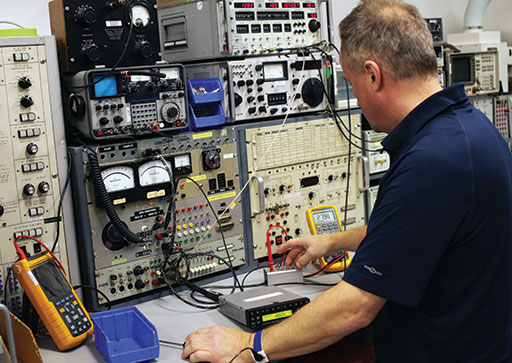
Honeywell’s Jason Bialek foresees “the potential of integrating serial number level maintenance history and reason-for-removal data as more feasible in an increasingly digital MRO environment.” He added that, “this will help technicians troubleshoot more efficiently to get products back to our customers. It will also be important to incorporate the right test points into products to streamline the troubleshooting process, and we will continue to refine automation and diagnostics in our test procedures to gain accuracy.”
Mid-Canada’s Bill Arsenault is looking forward to the possibilities outlined by Milum and Bialek. “More integrated and smarter avionics systems will only become easier to troubleshoot and repair, in my opinion,” he said. “Onboard diagnostic equipment helps the technician zero in on faults and potential causes.”
Meanwhile, Flying Colours’ Kevin Kliethermes sees the increasing abilities of avionics equipment driving regulatory demand for their mandatory use in aircraft, which will drive technological progress in this area further still.
“As aircraft systems become more complex, and more mandates are introduced though the NEXT GEN mandates — and flight deck navigation, safety and situational requirements like FANS and CPDLC datalink communications come into play — aircraft will need to be equipped to provide these services to fly within regulatory requirements,” said Kliethermes. “Connectivity is already important, but looking to the future it will be an essential part of the aircraft, with OEMs installing the relevant equipment during production. This affects all areas of avionics and our work will become more focused on repairing integral systems rather than retrofitting more up-to-date systems in the aftermarket sector.”
“Basically, there will be much more connectivity to and from the aircraft for the flight deck and passengers and this will be the prime focus going forward,” he observed. “Data management and how the avionics systems manage this will become more important, along with the need to protect this data through cyber security elements.”
Taken as a whole, avionics repair/replacement providers are dealing with a host of challenges as they weather the forces of technological change, COVID-19, and supply chain shortages. But based on the upbeat attitude of those providers who spoke with Aviation Maintenance for this story, they are embracing these challenges as opportunities for growth — and better service to their aviation customers.
